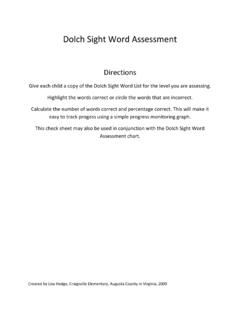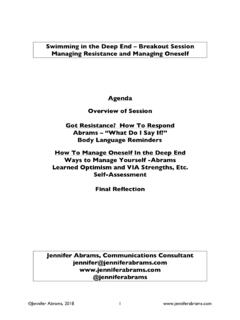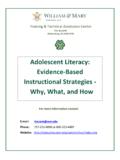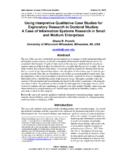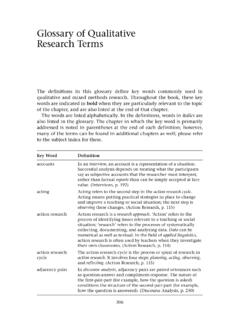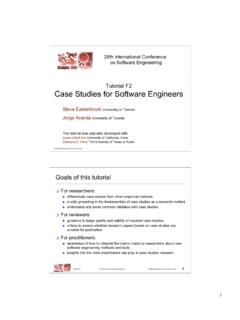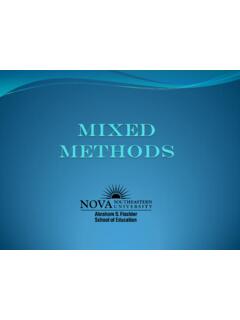Transcription of Sample Dissertation Overview
1 Sample Dissertation Overview The problem generally is addressed in two related parts: The problem statement is contained in Chapter 1, and a review of the related research, theory, and professional literature is described in Chapter 2. The methods used for investigating the problem are usually included in Chapter 3. The outcomes are traditionally presented in two chapters: Chapter 4 is normally devoted to reporting the results, and Chapter 5 presents the conclusions and implications drawn from the results. The various chapters are described in more detail in the following sections.
2 These are only general guidelines, however, and may be adjusted based on the nature and needs of a particular study . Chapter 1: Introduction In Chapter 1, a compelling case should be made regarding the problem under investigation, the purpose of the study , and research questions to be investigated. Where applicable, the theoretical or conceptual framework upon which the Dissertation is based should also be introduced. Statement of the Problem. This section should focus on why the particular study is needed. It should not be too long, but long enough to tell what the study will contribute to theory or the problem under consideration.
3 Theoretical or Conceptual Framework. The proposal should include a brief yet substantive summary of the theory that under girds the study and briefly summarizes previously conducted studies most relevant to the topic under investigation. A conceptual framework provides a narrative and sometimes a visual structure depicting the logical connections among key elements of the theory, constructs, and/or phenomenon of interest. Statement of the Purpose. A distinct, direct, short section that explicitly states what the study is about is often helpful.
4 This section describes specifically what the study will attempt to discover or accomplish. With a clear statement of purpose, the study becomes focused, the under girding logic becomes evident, and the relationship between what is going to be studied and how the study will be conducted becomes clearer. Research Questions. At this point, research questions are posed. They usually are succinct statements of the broad implications expected from the study . Depending upon the research paradigm guiding the study , hypotheses may be postulated.
5 Significance of the study . The study must be justified with respect to established theory, previously conducted research, and the significance of the anticipated results to practitioners and scholars. This is a broad statement as to why the study is important. Definition of Terms. You should define any technical terms necessary for the reader to understand; however, this usually does not include as much detail as the Dissertation itself. Chapter 2: Review of Literature This chapter serves as the foundation on which the study is built and as a basis for discussing results and interpretations.
6 It summarizes what is known and identifies what is unknown about the topic of the Dissertation study . The more extensive the previous work, the more involved the preparation of this chapter becomes. Likewise, there may be several areas of investigation related to the problem. Although a thorough review of the previous research and literature is a necessity, only that which has a direct bearing on the problem should be included. Unnecessary details should be avoided, but major findings and relevant methodological issues should be included.
7 It may be desirable to have a discussion section at the end of the review in which the implications of the previous studies are summarized and then are compared and contrasted with the study under investigation. Relevant examples of research that reports findings that do not support the case being made for the Dissertation should also be included. Chapter 3: Method The research design is described in sufficient detail in Chapter 3 that readers come away with a clear understanding of how the study will be conducted, and future researchers would know precisely what procedures to follow should they want to replicate this study .
8 Research Questions. The research questions presented in Chapter 1 should be replicated exactly near the beginning of Chapter 3. A brief introduction may precede these questions. study Design. The methods used in the study will be determined to a considerable extent by what is to be studied. A number of research design options usually are available to the investigator. The design ultimately selected will be described in this section. Each step in the execution of the research study should be described in detail. Appropriate citations making the case for the use of the chosen study design and procedures should be included.
9 study Context and Intervention (if applicable). If the study will examine the effects of a particular intervention or treatment, this should be described in detail. Participants. The participants in the study should be specified, indicating any relevant demographic information, as well as how participants were selected. The plan for recruitment of participants, as well as for resending invitations multiple times, or any incentives offered should be described. Data Sources. The tools used for measuring the variables in the study should be described.
10 Interview or focus group protocols should be described and the full set of directions and questions should be included in an appendix. Survey tools should provide information as to how the survey was developed and by whom, the number of items, subscales if applicable, the response set, Sample items, and validity and reliability information. The full measure should be included in an appendix if feasible. Data Collection. This section should describe in detail the means used to gather data. Data Analysis. In this section, readers learn what techniques and tools the research plans to use to analyze and summarize the data.

